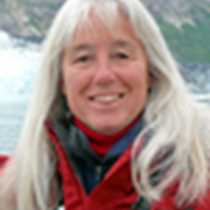Glacier Bay National Park
The National Geographic Sea Lion entered Glacier Bay National Park early this morning and proceeded to the dock at Park Headquarters – Bartlett Cove. Here, rangers Sarah and Patrick boarded our vessel to spend the day with us and we set off on our voyage to the far reaches of Glacier Bay. Sarah narrated the dramatic story of the park and Patrick kept the younger guests busy and interested with many activities.
We paused at South Marble Island to observe the Steller sea lions and the many species of seabirds that nest or rest here. They include pelagic cormorants, black-legged kittiwakes, glaucous-winged gulls, common murres and the lovable puffins.
We peeked into Tidal Inlet, where we found a group of mountain goats high on a green slope just below the clouds. As we turned to depart, a brown bear was spotted on the hillside. With the aid of our binoculars and spotting scope, we were able to see some details of this animal.
We passed Gloomy Knob, seeing a few more mountain goats and interesting geologic features – glacial striations and dolomitic marble rock.
Continuing up-bay, we approached the decomposing carcass of a humpback whale on shore, and found a brown bear feeding on it. After having its fill, the satiated bear walked off to nibble on some plants before heading into the forest. Park Service researchers have set up a motion-detection camera here to record information about visitors to the whale’s remains.
We cruised into Johns Hopkins Inlet and around Jaw Point for a view of the Johns Hopkins Glacier, one of only a few tidewater glaciers that are advancing. We noticed many harbor seals resting on recently-calved icebergs on our way up to the face of the glacier. We halted a quarter of a mile from the terminus of the massive river of ice. The glacier was very active today, with chunks of ice almost constantly falling from various locations along the face of the glacier, and punctuated occasionally by bigger episodes of splashing and thundering ice. An arch formed in the glacier’s face and we watched it grow into a deeper and wider cave as layers of ice kept letting go from the overhanging roof.
Lamplugh and Reid were our final tidewater glaciers as we retraced our wake back toward the entrance of the bay.
On our return, we cruised by the whale carcass again and received quite a bonus. Not only was the same bear we saw earlier feeding on the whale, but we found two other adult brown bears in a playful and seemingly amorous mood. It was a delight to watch their friendly courtship, wrestling and foreplay antics. Apparently she wasn’t quite ready but he was patiently willing to wait for the right moment, not letting her out of his sight. We’ll look for cubs in this area next year!
After dinner, we had a chance to get off the ship for a quick forest walk and/or a visit to the lodge with its excellent display area and gift shop.
We spent much of our time today observing wildlife, glaciers and spectacular scenery. Glacier Bay National Park is protected for these values and many others. It is a special place, the most remote and wild of our expedition. It offered us an experience of a lifetime, creating indelible memories.




